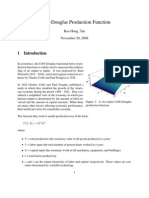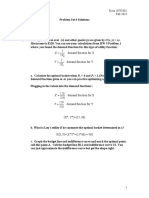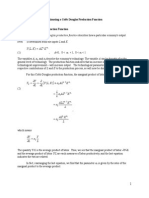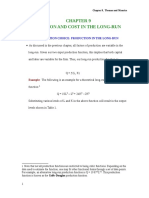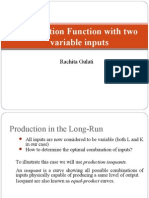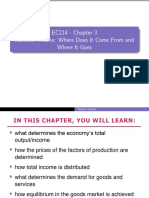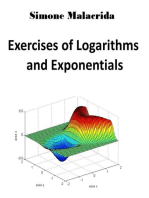Cobb Douglas B
Cobb Douglas B
Uploaded by
Sunita PatilCopyright:
Available Formats
Cobb Douglas B
Cobb Douglas B
Uploaded by
Sunita PatilOriginal Title
Copyright
Available Formats
Share this document
Did you find this document useful?
Is this content inappropriate?
Copyright:
Available Formats
Cobb Douglas B
Cobb Douglas B
Uploaded by
Sunita PatilCopyright:
Available Formats
Econ 30233
Intermediate Macroeconomics
John Lovett
Problem Set # 6 (For last 4 of IDs: 3334 6666) Characteristics of the Cobb-Douglas Production Function
Overview: In this problem set you will demonstrate the many desirable characteristics of the Cobb-Douglas production function. The Cobb-Douglas production function, for a model of the economy with only Capital (K) and Labor (L) as inputs is:
Y = KL(1-)
Where 0 < < 1
For this problem set, assume that = 0.6
Instructions 1. Demonstrate that the Cobb-Douglas production function is a constant returns to scale (CRS) production function. Do this by: a. Calculating Y when K = 20 and L = 40 b. Calculating Y when K = 40 and L = 80 c. Calculating Y when K = 100 and L = 200 d. Explain what constant returns to scale is. Explain how your numbers demonstrate, or fail to demonstrate, that the Cobb-Douglas function is CRS. 2. Demonstrate that the Cobb-Douglas production function exhibits diminishing marginal productivity of labor. Do this by: a. Hold K constant at 10. Vary L, in increments of 1 from 1 to 8. Calculate Y for each L. Then calculate the added output per added unit of Labor, i.e. MPL. Fill in the chart below.
K
10 10 10 10 10 10 10 10 10
L
0 1 2 3 4 5 6 7 8
1
Y
0
MPL =
NA
Y L
Econ 30233
Intermediate Macroeconomics
John Lovett
b. Explain what diminishing marginal productivity of labor is. Explain how your numbers demonstrate, or fail to demonstrate, that the Cobb-Douglas function exhibits diminishing marginal productivity of labor. 3. Demonstrate that the Cobb-Douglas production function exhibits diminishing marginal productivity of Capital. Do this by: a. Hold L constant at 10. Vary K, in increments of 1 from 1 to 8. Calculate Y for each L. Then calculate the added output per added unit of Labor, ie. MPK. Fill in the chart below.
L
10 10 10 10 10 10 10 10 10
K
0 1 2 3 4 5 6 7 8
Y
0
MPK =
NA
Y K
b. Explain what diminishing marginal productivity of capital is. Explain how your numbers demonstrate, or fail to demonstrate, that the Cobb-Douglas function exhibits diminishing marginal productivity of capital. 4. Demonstrate that the Cobb-Douglas production function abides by Eulers theorem. Do this by: a. Explain what Eulers theorem is and how it applies to production function. In particular, list the conditions (CRS, etc.) required for Eulers theorem to hold. The state the outcome (Y = something) according to Eulers theorem. b. Let K = 100 and L = 100. Calculate Y. c. Calculate the Marginal product of labor (MPL). To do this calculate Y when K = 100 and L = 99. The added output when L increases to 100, calculated in part b, is the MPL. d. Calculate the Marginal product of capital (MPK). To do this calculate Y when K = 99 and L = 100. The added output when K increases to 100, calculated in part b, is the MPK. e. Calculate KMPK + LMPL. Use the MPL and MPK you calculated in c and d respectively. Use 100 for K, and 100 for L. Does this equal Y when K = 100 and L = 100?1
1
Note: your results may be off by a tiny bit because we calculated MPL and MPK based on discrete changes instead of using calculus.
2
You might also like
- 666LeviathanTheBeastAsTheAntiChristPt 1Document420 pages666LeviathanTheBeastAsTheAntiChristPt 1Jikker Gigi Phatbeatzz Barrow93% (84)
- Price Action Technical Setups EbookDocument93 pagesPrice Action Technical Setups EbookAngeli Pirvulescu100% (24)
- WESS 2016 Intermediate Microeconomics Problem Set 1: Q LK W R W 4 R 2Document7 pagesWESS 2016 Intermediate Microeconomics Problem Set 1: Q LK W R W 4 R 2ანთეა აბრამიშვილიNo ratings yet
- David Weil Growth - NotesDocument93 pagesDavid Weil Growth - Notesjoydrambles100% (1)
- Chapter 4. Costs and Cost Minimization Problem Set: MP (L (LDocument10 pagesChapter 4. Costs and Cost Minimization Problem Set: MP (L (Lnomi9818No ratings yet
- 3070 PSet-5 SolutionsDocument10 pages3070 PSet-5 SolutionsvikasNo ratings yet
- New Managerial Econ CH 4 Lecture 7Document13 pagesNew Managerial Econ CH 4 Lecture 7kalkidankebede440No ratings yet
- Question 1Document7 pagesQuestion 1SounakNo ratings yet
- Cob Douglas Production TheoryDocument7 pagesCob Douglas Production Theoryamkumar1975No ratings yet
- Ej MicroDocument18 pagesEj MicronoegaesNo ratings yet
- 3070 PSet-4 SolutionsDocument11 pages3070 PSet-4 SolutionsvikasNo ratings yet
- Topic 3 Solution of Short Answer QuestionsDocument7 pagesTopic 3 Solution of Short Answer QuestionsTy VoNo ratings yet
- Cobb Douglas ProductionDocument4 pagesCobb Douglas ProductionMim ShakilNo ratings yet
- Mankiw10e Lecture Slides Ch03 2Document93 pagesMankiw10e Lecture Slides Ch03 2seonwoo4151No ratings yet
- Mankiw10e Lecture Slides ch03Document68 pagesMankiw10e Lecture Slides ch03alibakidom5922No ratings yet
- Lecture 3 - Solow Growth ModelDocument17 pagesLecture 3 - Solow Growth ModelGeri Camille MiroNo ratings yet
- The Cost of Production: VC AVC VC Q QDocument5 pagesThe Cost of Production: VC AVC VC Q QSuprabhat TiwariNo ratings yet
- Chapter 6 ProblemsDocument14 pagesChapter 6 ProblemsAhmadYaseenNo ratings yet
- I. Input Combination Choice: Production in The Long-RunDocument24 pagesI. Input Combination Choice: Production in The Long-RunSeyoum LeulNo ratings yet
- Mankiw10e Lecture Slides Ch03Document70 pagesMankiw10e Lecture Slides Ch03Anggi YudhaNo ratings yet
- Theory of The FirmDocument44 pagesTheory of The FirmMohiuddin GaalibNo ratings yet
- Ch3 Classical+Model+of+the+Closed+Economy+in+the+Long RunDocument49 pagesCh3 Classical+Model+of+the+Closed+Economy+in+the+Long RunnigaroNo ratings yet
- Production With Two Variable Inputs-FDocument39 pagesProduction With Two Variable Inputs-Fcancerdona67% (3)
- HW 2Document3 pagesHW 2mkaleemk1998No ratings yet
- MICROECONOMICS ch07ANNEXDocument6 pagesMICROECONOMICS ch07ANNEXSabrina GoNo ratings yet
- Handout 5: Production Functions and Cost MinimizationDocument10 pagesHandout 5: Production Functions and Cost MinimizationRaulNo ratings yet
- End-Of-Chapter Answers Chapter 7 PDFDocument12 pagesEnd-Of-Chapter Answers Chapter 7 PDFSiphoNo ratings yet
- ECN312 Problem Set 1Document2 pagesECN312 Problem Set 1puyaNo ratings yet
- Lecture Slides Chap03Document74 pagesLecture Slides Chap0322000492No ratings yet
- Exam AnswersDocument9 pagesExam AnswersGiorgi ChemiaNo ratings yet
- Theory of Cost & ProductionDocument4 pagesTheory of Cost & ProductionAkshay ModakNo ratings yet
- 3070 PSet-ch7 SolutionsDocument7 pages3070 PSet-ch7 Solutionsaryadaman08No ratings yet
- What To Produce How To Produce Efficient: MarginalDocument14 pagesWhat To Produce How To Produce Efficient: Marginalpratham262626No ratings yet
- Cobb-Douglas Production Function Revisited, VAR and VECM Analysis and A Note On Fischer - CobbDocument23 pagesCobb-Douglas Production Function Revisited, VAR and VECM Analysis and A Note On Fischer - CobbmuhilyaswameoNo ratings yet
- Msci 607: Applied Economics For Management Lecture 02 (Production and Cost) SolutionsDocument8 pagesMsci 607: Applied Economics For Management Lecture 02 (Production and Cost) SolutionsRonak PatelNo ratings yet
- PS2 SolsDocument12 pagesPS2 SolsMatthew ZukowskiNo ratings yet
- Chapter 6 (Math)Document7 pagesChapter 6 (Math)sadia risaNo ratings yet
- M07 Handout - Functions of Several VariablesDocument7 pagesM07 Handout - Functions of Several VariablesKatherine SauerNo ratings yet
- 2 Exercises Production CostsDocument9 pages2 Exercises Production CostsGretel MinayaNo ratings yet
- Cha4 Econ101 GLDocument29 pagesCha4 Econ101 GLGidisa LachisaNo ratings yet
- Chap3 ProbSolsDocument6 pagesChap3 ProbSolscadeyare1201No ratings yet
- Production Theory and EstimationDocument26 pagesProduction Theory and EstimationAqib ArshadNo ratings yet
- Prob 1Document4 pagesProb 1asnescribNo ratings yet
- EC214 - Chapter 3 National Income: Where Does It Come From and Where It GoesDocument72 pagesEC214 - Chapter 3 National Income: Where Does It Come From and Where It GoesUmay PelitNo ratings yet
- Slide 5_1Document11 pagesSlide 5_1Fawzul Azim RafidNo ratings yet
- National Income: Where It Comes From and Where It Goes: MacroeconomicsDocument72 pagesNational Income: Where It Comes From and Where It Goes: MacroeconomicsDaniesha ByfieldNo ratings yet
- Intermediate Macroeconomics Heman Das Lohano Assignment 2: Due On 17 May 2020 InstructionsDocument2 pagesIntermediate Macroeconomics Heman Das Lohano Assignment 2: Due On 17 May 2020 InstructionsMustafa Q ShamimNo ratings yet
- Ucla Economics 102 E. McdevittDocument8 pagesUcla Economics 102 E. McdevittVicky LiNo ratings yet
- Assignment 3 SolutionsDocument16 pagesAssignment 3 SolutionsAkniyetNo ratings yet
- Chap 07aDocument27 pagesChap 07aAli AtNo ratings yet
- Exercises On LectureDocument5 pagesExercises On LectureNawal TahaNo ratings yet
- Fall2017 MidtermDocument12 pagesFall2017 MidtermHui LiNo ratings yet
- Math PreliminariesDocument38 pagesMath PreliminariesMðų ÅdNo ratings yet
- Problem Set 1 StudentDocument2 pagesProblem Set 1 StudentNiceMoveNo ratings yet
- Homogeniety of Production FunctionDocument2 pagesHomogeniety of Production FunctionFariya HossainNo ratings yet
- Eco2211 Microeconomics Chapter 6 SlidesDocument21 pagesEco2211 Microeconomics Chapter 6 SlidesedizerdincNo ratings yet
- Econ305 L2 Summer2023Document35 pagesEcon305 L2 Summer2023fred B.No ratings yet
- Student Solutions Manual to Accompany Modern MacroeconomicsFrom EverandStudent Solutions Manual to Accompany Modern MacroeconomicsNo ratings yet
- Visual Financial Accounting for You: Greatly Modified Chess Positions as Financial and Accounting ConceptsFrom EverandVisual Financial Accounting for You: Greatly Modified Chess Positions as Financial and Accounting ConceptsNo ratings yet
- PSIR - Paper 1 - Sec B - AnalysisDocument4 pagesPSIR - Paper 1 - Sec B - AnalysisAnkurNo ratings yet
- Concurrence and Preference of CreditsDocument8 pagesConcurrence and Preference of CreditsLeeJongSuk isLifeNo ratings yet
- Q&A With Yehuda GiladDocument1 pageQ&A With Yehuda GiladcolburnsocialmediaNo ratings yet
- Animal BitesDocument5 pagesAnimal BitesvyalylaNo ratings yet
- d3dd PDFDocument14 pagesd3dd PDFManahil ShafeeqNo ratings yet
- Practical Workbook Ach-612 Petroleum and PetrochemicalsDocument17 pagesPractical Workbook Ach-612 Petroleum and PetrochemicalsMuhammad sherazNo ratings yet
- The Alphabet: An Expression of The Mystery of Man Dornach, 18th December 1921Document11 pagesThe Alphabet: An Expression of The Mystery of Man Dornach, 18th December 1921alinara100% (2)
- Brad BerryDocument6 pagesBrad BerryОля ЛиNo ratings yet
- 34 Newsletter 3rd July 2017Document14 pages34 Newsletter 3rd July 2017Magda CempuraNo ratings yet
- Strategi Segmenting, Targeting Dan Positioning Pemasaran Beras Merah Organik Jatiluwih Bali Di Provinsi BaliDocument10 pagesStrategi Segmenting, Targeting Dan Positioning Pemasaran Beras Merah Organik Jatiluwih Bali Di Provinsi Balithamvilo creatorNo ratings yet
- Toxoplasmosis and LaishmaniosisDocument49 pagesToxoplasmosis and LaishmaniosisTarikNo ratings yet
- Psychology and Marketing - 2022 - Chen - What Goes Around Comes Around The Effect of Belief in Karma On CharitableDocument13 pagesPsychology and Marketing - 2022 - Chen - What Goes Around Comes Around The Effect of Belief in Karma On CharitablefenrirelloboNo ratings yet
- Data Collection Methods: 1. Surveys: List of Closed or Multiple ChoiceDocument5 pagesData Collection Methods: 1. Surveys: List of Closed or Multiple ChoiceBree CastilloNo ratings yet
- Nursing Care Plan For Labor and Delivery Stages of Labor Diagnosis Intervention Rationale IndependentDocument7 pagesNursing Care Plan For Labor and Delivery Stages of Labor Diagnosis Intervention Rationale IndependentCLARISSE GEMROSE CUÑADANo ratings yet
- Lession Plan: Norton UniversityDocument5 pagesLession Plan: Norton UniversityIslam TahaNo ratings yet
- Self Adjudication With Dos (Edlagan)Document2 pagesSelf Adjudication With Dos (Edlagan)Arkim llovitNo ratings yet
- Massachusetts: Uquu JuncprnxrDocument17 pagesMassachusetts: Uquu JuncprnxrMarco RomeoNo ratings yet
- Maria Cecilia L. Catubig, PH.DDocument2 pagesMaria Cecilia L. Catubig, PH.DAudrey Kristina MaypaNo ratings yet
- PDF Trust Management IX 9th IFIP WG 11 11 International Conference IFIPTM 2015 Hamburg Germany May 26 28 2015 Proceedings 1st Edition Christian Damsgaard Jensen downloadDocument63 pagesPDF Trust Management IX 9th IFIP WG 11 11 International Conference IFIPTM 2015 Hamburg Germany May 26 28 2015 Proceedings 1st Edition Christian Damsgaard Jensen downloadnkwananocum100% (1)
- 3:9:23 PM ChurchDocument9 pages3:9:23 PM Churchevangelinegrace05No ratings yet
- ActivityDocument2 pagesActivityJuan Pablo González LondoñoNo ratings yet
- (With Inclusion of The Provisions of Deped Order No. 8, S. 2015 and D.O. 42, 2016) Detailed Lesson Plan (DLP) FormatDocument5 pages(With Inclusion of The Provisions of Deped Order No. 8, S. 2015 and D.O. 42, 2016) Detailed Lesson Plan (DLP) FormatJoong SeoNo ratings yet
- HBR PuzzlesDocument4 pagesHBR PuzzlesumershNo ratings yet
- Drug Free PolicyDocument5 pagesDrug Free Policymike_val100% (1)
- Vaccines Depopulation PDFDocument11 pagesVaccines Depopulation PDFSidNo ratings yet
- ACTAX-3153-N002-Intro To Income Taxation PDFDocument5 pagesACTAX-3153-N002-Intro To Income Taxation PDFJwyneth Royce DenolanNo ratings yet
- Development StagesDocument1 pageDevelopment Stagesapi-253577989No ratings yet
- ArpivaDocument8 pagesArpivavahrmNo ratings yet








